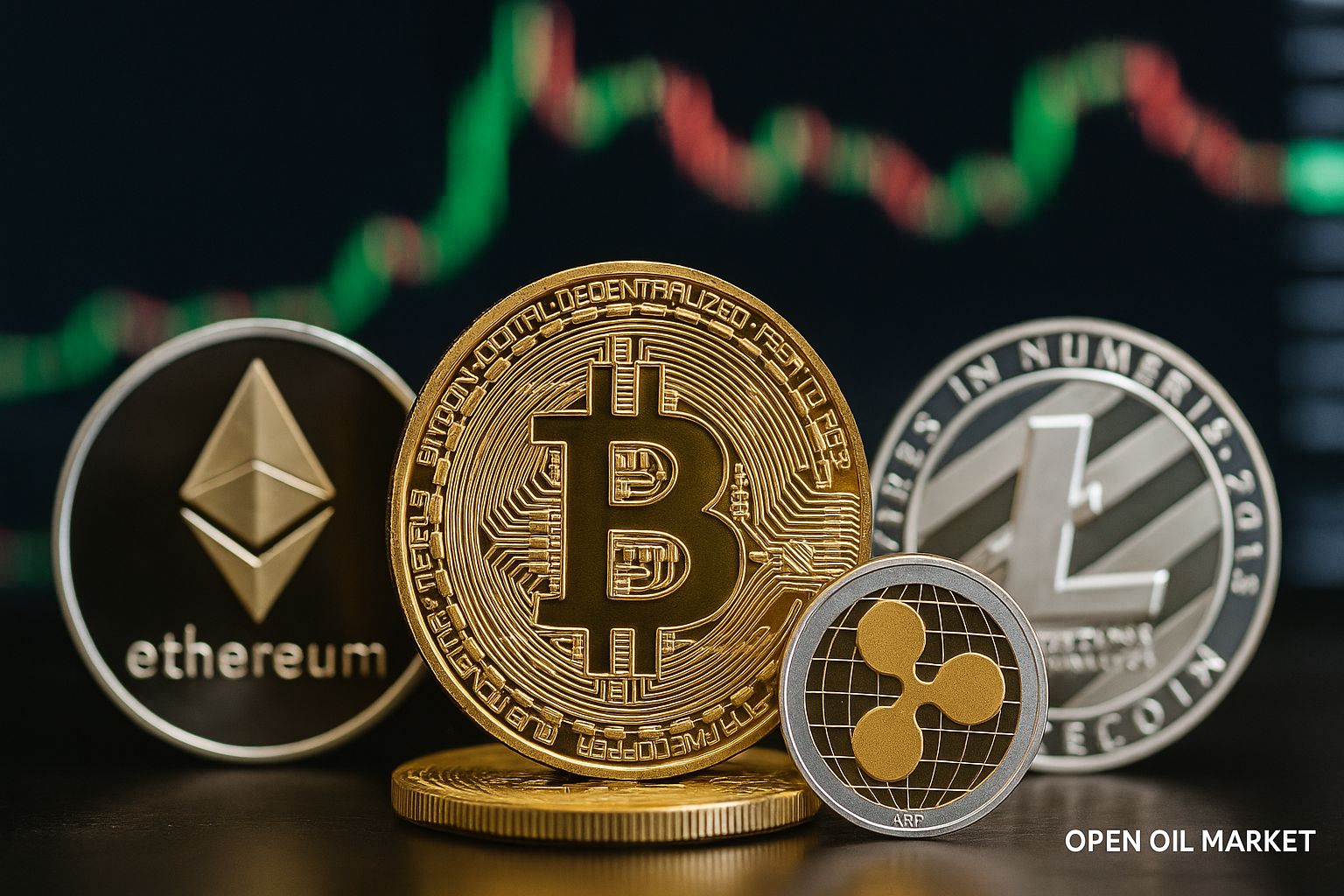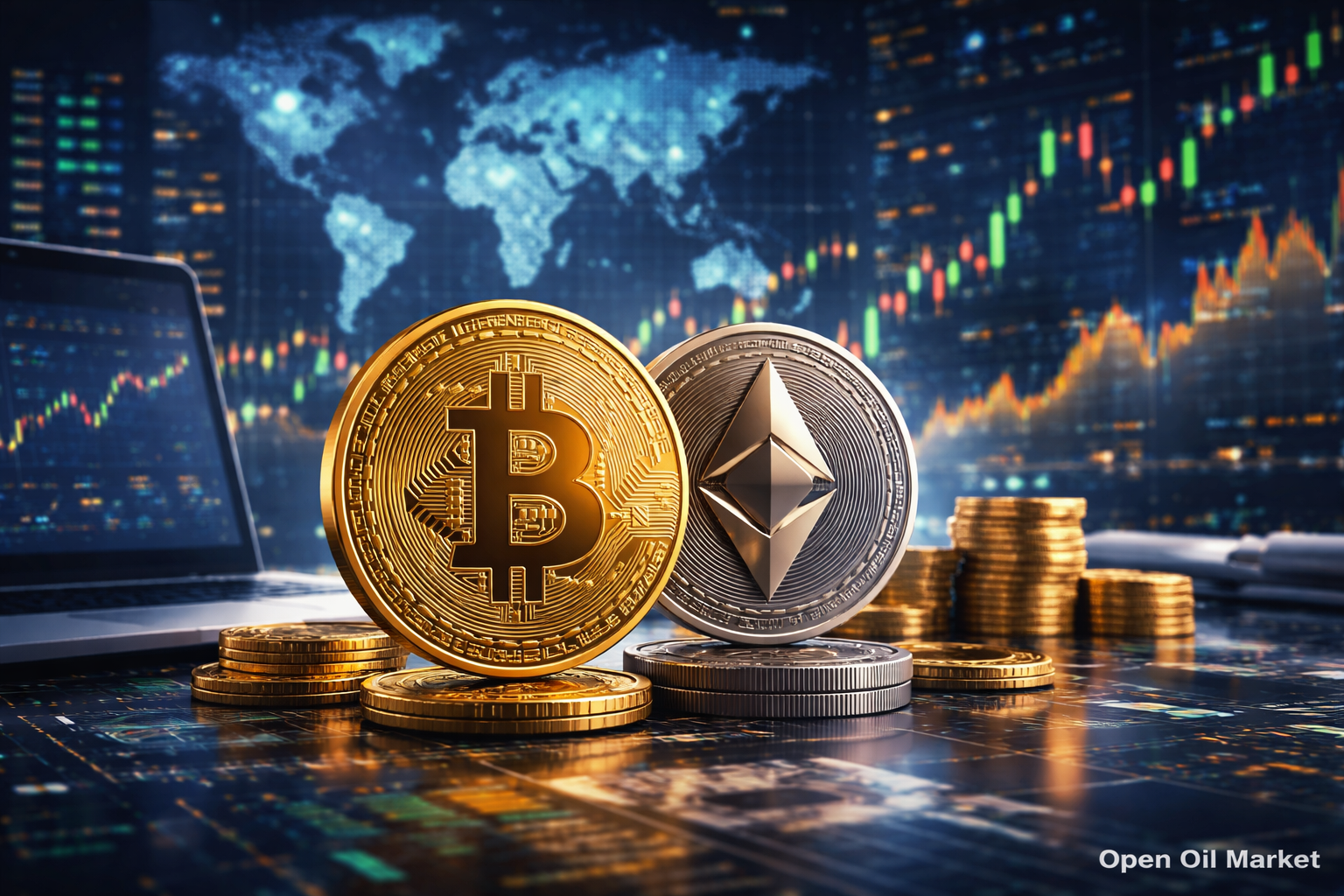
Fresh Cryptocurrency News: October 13, 2025 - Bitcoin Corrects After Volatile Weekend, Ethereum Hits New High, Market Maintains Bullish Trend. Analysis and Prospects for Investors.
As of the morning of October 13, 2025, the cryptocurrency market is exhibiting mixed dynamics following recent price records. Last week, Bitcoin's price approached $130,000 for the first time, boosting the total market capitalization of digital assets above $4.5 trillion. However, over the weekend, a sharp correction ensued: news of the U.S. plans to impose 100% tariffs on imports from China triggered a short-term capital outflow from risk assets. Consequently, Bitcoin temporarily dipped to approximately $110,000, reminding investors of the high volatility characteristic of the crypto market. Nevertheless, overall sentiment remains positive: most major altcoins are holding near their recent highs, while institutional investors continue to increase their investments amid a favorable macroeconomic environment and regulatory support.
Records and Correction: Bitcoin Faces Volatility
At the beginning of October, Bitcoin (BTC) set a new yearly high, surpassing $130,000 on some exchanges. The growth of the leading cryptocurrency was fueled by seasonal optimism among investors (the "Uptober" effect), record capital inflows into spot crypto ETFs, and expectations of monetary policy easing. However, after the surge above $130,000, the market confronted volatility: the announcement of new U.S. trade tariffs against China led to an immediate sell-off. The price of BTC dropped approximately 10% within minutes, stabilizing around $112,000 before recovering. Currently, Bitcoin is trading near $120,000, still significantly higher than the levels from a month ago. The market capitalization of BTC exceeds $2.4 trillion (around 58% of the total cryptocurrency market). Despite the recent pullback, many analysts maintain a bullish outlook: investment banks JPMorgan and Standard Chartered still foresee Bitcoin rising to $165,000–200,000 by year-end if current trends persist. Meanwhile, the altcoin season index has exceeded 70 points, signaling that investor activity is gradually shifting towards alternative coins as Bitcoin reaches new peaks.
Ethereum Sets New All-Time High
Following Bitcoin's lead, Ethereum (ETH), the second-largest cryptocurrency by market capitalization, is also experiencing rapid growth. Over the weekend trading, Ethereum surpassed its all-time high for the first time since 2021, climbing above $4,900 and beating the peak of the last bullish phase ($4,890). By Monday morning, ETH had slightly corrected and is holding around $4,800, still close to record values, with its market cap around $580 billion (approximately 14% of the market). The uptick in Ethereum's price is supported by rising interest in the smart contracts platform and expectations of the imminent launch of the first spot ETF on ETH in the U.S. Institutional investors are actively building positions: at the beginning of October, open interest for Ethereum futures on the Chicago Mercantile Exchange (CME) reached an all-time high, exceeding $11 billion in equivalent, reflecting heightened interest from large players. Additional momentum is provided by the upcoming technical upgrade of the Ethereum network, codenamed "Fusaka," scheduled for the second half of October. It is expected to enhance the scalability and security of the network, boosting community confidence in ETH's long-term potential.
Altcoins: Broad-Based Growth Continues
The broader altcoin market is generally maintaining an upward trend. Most of the largest alternative coins in the top 10 are trading significantly higher than a month ago, reflecting new capital inflows. For example, Binance Coin (BNB) has gained approximately 30% in recent weeks, recently surpassing the psychological threshold of $1,000 due to active usage within the BNB Chain ecosystem. Following such rapid growth, technical analysis indicators signal overbought conditions (with BNB's RSI exceeding 70), hence a correction may be on the horizon, which partially occurred over the weekend (with BNB retracting to about $950). The second most popular altcoin, Solana (SOL), has held above $180, close to its 2023 highs, spurred by interest in its DeFi projects. XRP, the token of the Ripple network, has stabilized around $3 after a sharp surge this summer—Ripple's legal victory in the U.S. previously alleviated regulatory risks and elevated XRP’s value to its highest levels since 2018. The total capitalization of altcoins (excluding Bitcoin) now exceeds $1.8 trillion. Some projects are approaching their own record prices, intensifying expectations for a full-fledged "alt season." Experts note that full-scale rallies of alternative coins typically begin when Bitcoin's market share declines—Bitcoin's current dominance of around 58-60% could indicate room for further altcoin growth if some capital shifts towards them.
Regulatory Agenda: Improved Rules Support the Market
Certainty regarding regulation continues to grow, instilling additional confidence in investors. This past summer, the U.S. passed the nation's first cryptocurrency law—the GENIUS Act—which established rules for stablecoin issuers and laid the groundwork for broader regulation of digital assets. This law provides a clear legal status for payment stablecoins (which are not classified as securities), and mandates issuers to adhere to strict reserve and transparency requirements. Concurrently, the Securities and Exchange Commission (SEC) is reviewing applications for the launch of new crypto ETFs: in the latter half of October, the market is anticipating decisions on spot funds for XRP and Solana. Approval of these products would grant institutional investors even broader access to altcoins through regulated instruments. In Europe, the rollout of the MiCA regulatory framework continues, aimed at standardizing oversight of crypto assets across EU countries and enhancing consumer protection. In Asia’s financial hub, Hong Kong, new stablecoin licensing regulations have come into effect, promoting sector development under government oversight. Overall, the global trend is clear: authorities in leading economies are transitioning from prohibitive rhetoric to integrating cryptocurrencies into the financial system under clear conditions. This creates more stable conditions for market development and reduces the risks of sudden bans or sanctions.
Institutional and Corporate Investments Gaining Momentum
Major financial players are increasingly expanding their presence in the crypto market. Notably, there has been a significant shift on Wall Street: one of the largest U.S. banks, Morgan Stanley, has lifted restrictions on its clients' investments in digital assets, including Ethereum. This move reflects the changing attitude of traditional institutions towards cryptocurrencies and their desire to meet wealthy clients' demand for this new asset class. Meanwhile, the influx into institutional crypto products is hitting records: according to ForkLog, since the beginning of 2025, total investments in exchange-traded crypto funds (ETPs) have reached approximately $48.7 billion, exceeding last year’s total. Bitcoin ETFs are particularly popular: in the third quarter alone, such funds attracted about $7.8 billion in new investments, indicating continued high interest from hedge funds, investment banks, and even some pension plans. The stablecoin sector is also keeping pace: Tether recently raised funding, increasing its valuation to $500 billion, and is investing in new projects (such as the Plasma platform for zero-fee stablecoins). Additionally, new instances of corporate and fund involvement in the crypto industry are emerging—ranging from including cryptocurrencies in reserve assets to allocating part of sovereign funds in digital assets. For instance, the sovereign fund of Luxembourg became the first in the Eurozone to invest about 1% of its portfolio (approximately $9 million) in a Bitcoin ETF. Such decisions from conservative investors demonstrate that cryptocurrencies are solidifying their status as a full-fledged element of the global financial system.
Countries and Global Initiatives Towards Cryptocurrency Integration
Across various countries, governments are taking steps to integrate cryptocurrencies into their economies on their terms. In Russia, work has commenced on an experimental legal regime for the circulation of digital assets and mining. According to the Russian Ministry of Finance, infrastructure will be created in the coming months to allow "specialized investors" to legally invest in crypto assets within a sandbox under the oversight of the Central Bank of Russia. Although the formal status of cryptocurrencies as a payment method remains prohibited in Russia, the emergence of a national platform for trading digital assets could provide legal protection for market participants and attract additional investments into the sector (including the development of Russian mining). Other developing economies are also actively adopting cryptocurrencies: Brazil recently reported that its domestic crypto transaction volume exceeded $318 billion over the past year, reflecting widespread adoption of digital currencies among its population. In Nigeria, local regulators, with the support of the central bank, are developing a national stablecoin for domestic payments, aiming to improve payment efficiency and financial accessibility. Positive changes are also occurring in developed nations. In Luxembourg, in addition to the sovereign fund's investment in Bitcoin, the government approved legislative changes allowing sovereign funds and institutions to own crypto assets. Overall, competition for leadership in the digital currency space at the government level is intensifying: while some jurisdictions are launching their own central bank digital currencies (CBDCs), others are promoting private crypto projects and establishing favorable regimes for blockchain startups. This global process underscores the transition of the world financial system to a new, digital form, where cryptocurrencies play an increasingly prominent role.
Top 10 Most Popular Cryptocurrencies
As of the morning of October 13, 2025, the following digital assets are included in the top ten cryptocurrencies by market capitalization:
- Bitcoin (BTC) — the first and most capitalized cryptocurrency. BTC is trading near $120,000 after a volatile weekend, with a market capitalization exceeding $2.4 trillion (approximately 58% of the entire market). Bitcoin is often referred to as "digital gold" due to its limited emissions (21 million coins), making it a hedge against inflation. However, BTC mining remains energy-intensive and relies on the availability of cheap electricity, raising discussions about environmental sustainability.
- Ethereum (ETH) — the leading altcoin and smart contracts platform. The price of ETH holds around $4,800, close to its all-time high, with a market capitalization of approximately $580 billion (around 14% of the market). Last year, Ethereum transitioned to a Proof-of-Stake algorithm, reducing energy consumption by more than 99%. The Ethereum blockchain underpins the DeFi and NFT ecosystems, although transaction fees (gas fees) remain high during peak periods.
- Tether (USDT) — the largest stablecoin, pegged to the U.S. dollar at a 1:1 ratio. USDT is widely used for trading operations and settlements on crypto exchanges, providing liquidity between various crypto assets. Its market capitalization is around $170 billion, and its price is consistently maintained at $1.00 per token due to the issuer's reserves. Tether regularly publishes reports on its reserves, although the project has faced transparency issues in the past.
- Ripple (XRP) — the token of the Ripple payment network, designed for fast cross-border transactions. XRP is currently trading around $3.10, with a market capitalization of approximately $175 billion. In 2025, the token sharply increased in price after an American court confirmed that XRP sales on the secondary market do not violate securities laws—this removed years of uncertainty and returned XRP to the top three leaders. Ripple's advantages include high transaction speeds (seconds) and low fees, making it attractive to banks and financial companies. The primary risk is that a significant portion of the total XRP supply is owned by entities related to Ripple Labs, raising concerns about centralization.
- Binance Coin (BNB) — the native coin of the largest cryptocurrency exchange, Binance, and the base token of the BNB Chain blockchain. BNB is worth around $950 following a recent surge (market capitalization is about $140 billion), approaching its all-time high. The coin plays a critical role in the Binance ecosystem: it is used to pay trading fees with discounts and is utilized in numerous DeFi applications and services on the BNB Chain. Despite intensified regulatory pressure on the Binance exchange in several countries, BNB's wide range of applications allows it to remain in the top five crypto assets.
- Solana (SOL) — a high-performance blockchain platform for decentralized applications and finance (DeFi). SOL trades around $190 per coin (market capitalization ~ $88 billion), having strengthened in recent months due to its network's scalability. Solana can process thousands of transactions per second with minimal fees, attracting developers and projects (from DEXs to NFT marketplaces). Nonetheless, Solana has previously experienced technical failures and network outages, temporarily undermining trust—the project team continues to work on enhancing the network’s reliability and decentralization.
- USD Coin (USDC) — the second-largest stablecoin, issued by Circle in partnership with Coinbase. The price of USDC is consistently maintained at $1.00 through 100% backing with dollar reserves held in bank accounts and treasury bonds. The current market capitalization of USDC is about $65 billion. This stablecoin enjoys particular trust among institutional investors and DeFi participants due to its regular reserve audits and complete transparency for regulators.
- Cardano (ADA) — a blockchain platform developing based on a scientific approach and peer-reviewed research. The ADA token trades at around $0.95 (market capitalization ~ $32 billion) following a recent uptick. The Cardano community is eagerly anticipating the deployment of new features, including tier-2 smart contract support and the launch of its own ETF on ADA, which could attract additional capital. The project is known for its gradual, carefully verified network upgrades—this ensures high reliability, but the slow pace of updates sometimes disappoints investors seeking faster results.
- TRON (TRX) — a blockchain for smart contracts and multimedia decentralized applications, particularly popular in Asia. TRX trades around $0.34 (market capitalization ~ $32 billion) and remains among the top cryptocurrencies, partly due to the active use of the TRON network for stablecoin issuance (a significant share of USDT circulates on the TRON blockchain). TRON's advantages include low fees and high transaction speeds, making it attractive for various services. However, critics point out the risk of centralization: the managing entity, Tron Foundation, and associated structures have substantial influence over the ecosystem's development.
- Dogecoin (DOGE) — the most renowned meme cryptocurrency, created as a joke but has since gained immense popularity. DOGE hovers near $0.19 (market capitalization ~ $33 billion) due to the loyalty and activity of its community, as well as periodic attention from celebrities and major business figures. Despite its lack of fundamental value and high volatility (DOGE prices can spike or drop dramatically on social media news), this token surprisingly remains stable in the top 10. Dogecoin serves as a sort of sentiment indicator for retail investors: during market uptrends, interest in DOGE rises, confirming participants' willingness to take risks for potential high returns.
Expectations for the Coming Week and Conclusions
The beginning of October has confirmed that the cryptocurrency market remains sensitive to sudden external factors. Macroeconomic and geopolitical events (such as tariff news or inflation statistics) can trigger short-term volatility spikes, even amidst an overall bullish trend. Nevertheless, the fundamental drivers of growth remain intact: institutional demand and technological developments in the industry continue to propel the market forward. In the upcoming week, investors will closely monitor regulatory decisions and significant economic statistics releases. In the latter half of October, verdicts from the SEC on spot ETFs for certain altcoins (including XRP and SOL) are anticipated—any outcome from these applications may significantly impact the related assets and market sentiment. Market participants are also preparing for the Ethereum technical upgrade ("Fusaka"), which might affect the DeFi ecosystem. Traditional risk factors will focus on fresh inflation data in the U.S. and Europe: a moderate slowdown in price growth may bolster hopes for timely monetary policy easing, which typically benefits cryptocurrencies.
Analysts advise investors to exercise caution following the rapid rally over the past months. Sudden price surges often give way to correction periods, as evidenced by the events of the past weekend. In these conditions, it is crucial to adhere to risk management principles: diversify the portfolio by combining leading assets (BTC, ETH) with promising altcoins, and monitor fundamental indicators of projects. Special attention should also be given to the token unlocking schedule for major projects—sharp increases in market supply can temporarily pressure prices. Overall, however, the long-term trend for the cryptocurrency market remains bullish: improvements in regulatory frameworks, influxes of institutional investments, and innovations in the industry form a solid foundation for further growth in the market capitalization of digital assets. Despite potential short-term fluctuations, cryptocurrencies continue to strengthen their positions within the global financial system, attracting more investors and solidifying their status as a full-fledged investment asset class.




